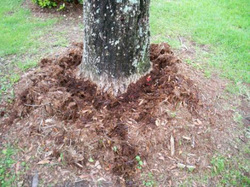
Another major practice that we know greatly benefits trees is mulching. Trees and many other plants benefit tremendously from mulching because mulching reduces soil compaction, suppresses weeds, conserves moisture, and regulates soil temperatures. Also, as mulch decomposes it softens the surface of the soil underneath it, which in turn, increases the percolation of water to feeder roots. Mulching adds beneficial nutrients and improves the soil structure.
There are a couple of common practices that I encounter too often during many of my home or site visits to survey problems with trees. The first is when I come across nice established trees that are being heavily damaged by both homeowners and professional landscape maintenance professionals, or city or parish employees with string trimmers/weed eaters and lawn mowers. The major damage occurs a couple of inches above the soil line to the major trunks. This resulting damage is stripping or gouging bark which leads to severe stunting or death. It makes me wonder if this problem comes from not be aware or being in a hurry and not being careful. Either way, the damage is unnecessary and harmful to trees, especially when compounded by the normal stresses placed on trees by pests, drought, excessive rainfall, poor drainage, and wind damage!!
The other practice is improper mulching!! For the life of me I don’t understand why anyone would take the extra time to pile mulch 8, 10, or 12 inches high and tight around the trunk of any tree or plant. This leads to all kind of problems and diminishes all of the benefits of mulching that I discussed earlier in this article. Dan Gill and Allen Owings refer to this as “volcanic mulching” since when viewed from the side, the mulch comes to a peak high against the trunk of a tree. Plain and simple, this can lead to serious issues of rotting. Anytime mulch is place over the root flare of trees (the point where the main trunk and the roots meet), it increases the potential for rot. Certain species of trees are susceptible. Trees that don’t tolerate less than ideal drainage or are located in poorly drained areas are much more likely to have rot issues, again leading to stunting , poor performance and possibly death. I communicated with Dr. Owings this morning, and he reiter-ated that no mulch should be piled high and tight against the trunk of any tree. Mulch should be spread out ideally to the drip line or canopy edge to an average maximum depth of 4 inches, and then, top off every 6 -12 months or so to replenish after it decomposes and settles.
Based on my personal experiences during visits all over Lafayette and surrounding Parishes, mulching properly and avoiding dam-ages to trees with lawn mowers and string trimmers would go a long way towards maintaining tree health at a level where we can enjoy the great benefit provided to us and wildlife by trees. I truly believe that as educators, it is our responsibility to informed the uninformed, make aware the unaware, by politely pointing out incidences of improper mulching and physical damages whenever we witness either.

 RSS Feed
RSS Feed